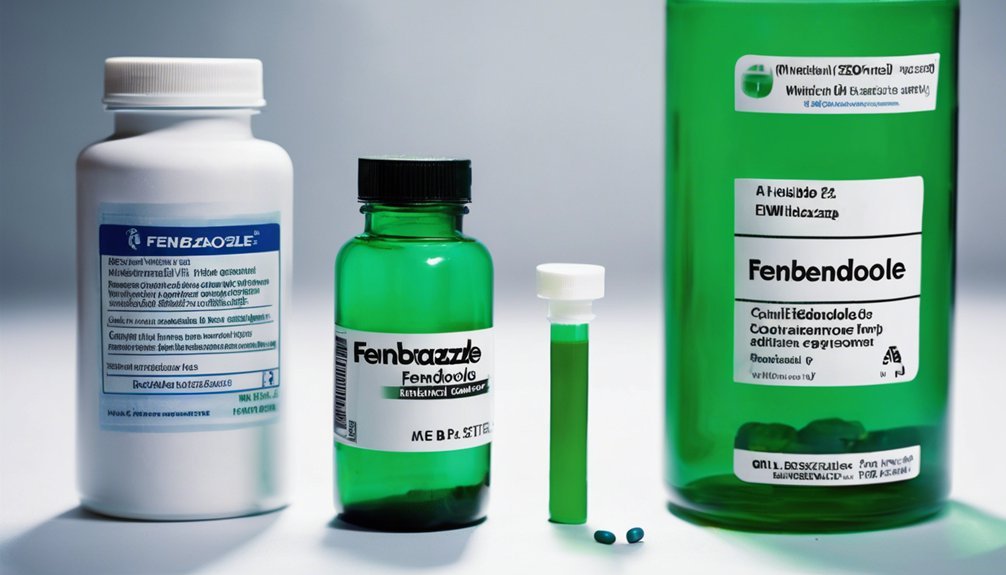Anthelmintic resistance affects approximately 40% of global livestock, creating a pressing need for effective alternatives. In this context, Fenbendazole and Mebendazole emerge as two contrasting candidates for drug repurposing. While Fenbendazole shows potential in veterinary medicine, Mebendazole holds FDA approval for human use. However, each drug presents unique challenges in pharmacokinetics and safety profiles. Understanding these differences could be key to optimizing treatment strategies against resistant parasitic infections. What implications does this hold for future therapies?
Key Takeaways
- Fenbendazole and Mebendazole exhibit different mechanisms of action, influencing their potential effectiveness in biphasic drug repurposing strategies.
- The pharmacokinetics of Fenbendazole necessitate multiple doses for efficacy, while Mebendazole’s short half-life requires careful dosing considerations.
- Drug resistance mechanisms affect both agents, highlighting the need for innovative repurposing approaches to enhance their therapeutic effectiveness.
- Fenbendazole’s investigational status for human use contrasts with Mebendazole’s established FDA approval, impacting their roles in clinical settings.
- Combination therapies using both drugs may improve treatment outcomes and mitigate resistance, making them viable candidates for biphasic drug repurposing.
Overview of Anthelmintic Agents

Anthelmintic agents play a crucial role in treating parasitic worm infections, targeting a variety of helminths that affect both humans and animals.
As a healthcare provider, you must be aware of the challenges posed by anthelmintic resistance, which complicates treatment regimens and necessitates innovative approaches in drug discovery.
Resistance emerges from factors like overuse and misapplication of existing agents, making it imperative to explore new compounds and repurpose established drugs.
Overuse and misapplication of anthelmintics drive resistance, highlighting the urgent need for new drug discovery and repurposing efforts.
In your efforts to serve vulnerable populations, understanding the pharmacodynamics and spectrum of activity of agents like fenbendazole and mebendazole is essential.
Mechanisms of Action
While understanding the mechanisms of action for fenbendazole and mebendazole, you’ll notice that both drugs disrupt the physiology of parasitic worms, albeit through different pathways. Fenbendazole primarily targets the beta-tubulin within the parasite’s microtubules, leading to impaired cellular functions. In contrast, mebendazole exerts its effect by binding to specific cellular targets, disrupting glucose uptake and energy metabolism. Both drugs may exhibit drug interactions that can influence their efficacy and safety profiles.
| Mechanism | Fenbendazole |
|---|---|
| Cellular Target | Beta-tubulin |
| Action | Disrupts microtubule formation |
| Energy Metabolism | Impairs glucose uptake |
| Drug Interactions | Potential with other anthelmintics |
| Efficacy | Variable based on dosage |
Understanding these differences can enhance your approach to treatment strategies.
Pharmacokinetics of Fenbendazole
Understanding the pharmacokinetics of fenbendazole is crucial for optimizing its use in treating parasitic infections.
Analyzing its absorption and metabolism can significantly enhance therapeutic strategies. Here are key aspects to consider:
- Absorption: Fenbendazole exhibits variable bioavailability, influenced by food intake.
- Metabolism: It undergoes hepatic metabolism primarily via cytochrome P450 enzymes.
- Half-life: The drug has a relatively short half-life, necessitating multiple doses for sustained efficacy.
- Distribution: Fenbendazole distributes widely in tissues, ensuring effective parasite targeting.
- Excretion: Renal pathways primarily eliminate metabolites, highlighting the importance of kidney function in treatment.
Pharmacokinetics of Mebendazole

Mebendazole’s pharmacokinetics play a pivotal role in its effectiveness against various helminthic infections.
You’ll find that Mebendazole absorption is relatively poor, with peak plasma concentrations reached 2 to 4 hours post-administration. This limited bioavailability is primarily due to its extensive first-pass metabolism, converting it into various metabolites, which can influence its therapeutic efficacy.
Notably, the drug’s solubility in lipids enhances its metabolism, affecting the concentration of active forms in circulation. The half-life of Mebendazole is approximately 2.5 to 5 hours, necessitating careful dosing to maintain effective levels.
Understanding these pharmacokinetic parameters allows healthcare professionals to optimize treatment regimens, ensuring that Mebendazole achieves its full potential against parasitic infections while considering patient-specific factors.
Therapeutic Uses in Parasitic Infections
When considering therapeutic uses in parasitic infections, both Fenbendazole and Mebendazole demonstrate significant efficacy against a range of helminths. Their therapeutic applications are crucial in treating infections, especially in resource-limited settings.
Key aspects of their clinical efficacy include:
- Broad-spectrum activity against diverse helminths
- Safe administration across various age groups
- Minimal side effects, enhancing patient compliance
- Cost-effectiveness, making treatment accessible
- Established use in veterinary medicine, indicating reliability
These properties highlight how both drugs can effectively serve populations suffering from parasitic infections.
Understanding their distinct roles can help you choose the most suitable option for your clinical context, ensuring better health outcomes for those in need.
Emerging Research in Oncology
Recent advancements in the field of oncology have sparked interest in the repurposing of antiparasitic medications like Fenbendazole and Mebendazole as potential therapeutic agents against certain cancers.
These compounds exhibit mechanisms that may disrupt critical cancer pathways, offering novel therapies for treatment-resistant tumors. Research indicates that both drugs can induce apoptosis and inhibit cell proliferation, making them attractive candidates for clinical exploration.
Studies are investigating their synergistic effects when combined with established chemotherapeutics, potentially enhancing efficacy.
As you consider these findings, it’s essential to remain informed about ongoing trials that evaluate these agents’ safety and effectiveness in oncology. This emerging research could pave the way for innovative strategies in cancer management, ultimately serving patients more effectively.
Potential Off-Label Applications

As researchers explore the potential off-label applications of Fenbendazole and Mebendazole, their promising mechanisms of action against various conditions are coming to light.
You might consider the following off-label uses for these anthelmintics:
- Cancer treatment: Both drugs exhibit cytotoxic properties that may aid in oncology.
- Anti-inflammatory effects: Their mechanisms suggest potential benefits in inflammatory diseases.
- Neurological disorders: Emerging studies indicate possible neuroprotective roles.
- Metabolic syndrome: These compounds might influence metabolic pathways, offering new therapeutic angles.
- Antiviral properties: There’s growing evidence of efficacy against certain viral infections.
When considering these off-label uses, it’s crucial to evaluate potential drug interactions and consult with healthcare professionals to ensure patient safety and optimal treatment outcomes.
Safety Profiles and Side Effects
While evaluating the safety profiles of Fenbendazole and Mebendazole, it’s essential to consider their side effects and potential risks. Both medications exhibit a range of adverse reactions, though their incidence and severity can differ.
Fenbendazole is generally well-tolerated, with mild gastrointestinal disturbances being the most common side effects.
Fenbendazole is typically well-tolerated, with mild gastrointestinal issues as the most frequent side effects.
In contrast, Mebendazole may present a broader spectrum of risk factors, including potential hepatotoxicity and allergic reactions.
It’s crucial to assess patient history, as pre-existing conditions could heighten these risks. Monitoring for any adverse reactions during treatment can help ensure patient safety and efficacy.
Ultimately, understanding these safety profiles aids in making informed decisions while serving the needs of those you aim to help.
Comparative Effectiveness
Understanding the safety profiles of Fenbendazole and Mebendazole lays the groundwork for evaluating their comparative effectiveness in treating various parasitic infections.
In examining the efficacy comparison, clinical trials reveal critical insights into how each drug performs against specific parasites. You’ll want to consider:
- Spectrum of activity against different parasites
- Dosage requirements and administration frequency
- Duration of treatment and resulting outcomes
- Rate of side effects and patient tolerability
- Availability and cost-effectiveness for patients
These factors are essential in determining which drug may be more suitable for individual cases.
Regulatory Status and Approval

When evaluating the regulatory status and approval of Fenbendazole and Mebendazole, it’s crucial to recognize the distinct pathways each drug has taken through regulatory agencies. Both drugs face unique regulatory hurdles that influence their repurposing potential.
| Drug | Approval Status | Regulatory Pathway |
|---|---|---|
| Fenbendazole | Approved | Veterinary use; Investigational for human use |
| Mebendazole | Approved | FDA-approved for human use; established efficacy in specific conditions |
| Common Uses | Anti-parasitic | Anti-parasitic and potential anti-cancer |
| Regulatory Hurdles | Limited for fenbendazole | Established for mebendazole |
| Current Research | Ongoing studies | Clinical trials underway |
Understanding these approval pathways can help you navigate the complexities of drug repurposing, ultimately benefiting patients who need effective treatments.
Mechanisms of Drug Resistance
As drug resistance develops, it significantly impacts the efficacy of treatments like Fenbendazole and Mebendazole.
Understanding the drug resistance mechanisms and parasite adaptations is crucial for effective intervention strategies.
Key mechanisms include:
- Altered drug targets: Changes in binding sites reduce drug effectiveness.
- Efflux pumps: Parasites may expel drugs, decreasing their intracellular concentrations.
- Metabolic modifications: Enhanced metabolic pathways can detoxify drugs.
- Genetic mutations: Mutations in critical genes can confer resistance.
- Biofilm formation: Some parasites form protective biofilms, shielding them from treatment.
Recognizing these mechanisms helps you devise better strategies to combat resistance, ensuring that treatments remain effective and accessible for those in need.
Future Directions in Drug Repurposing
The challenges posed by drug resistance necessitate innovative approaches in the fight against parasitic infections. Future trends in drug repurposing will likely focus on harnessing existing medications, such as Fenbendazole and Mebendazole, to combat resistance patterns effectively.
You might explore combination therapies, leveraging synergistic effects to enhance efficacy while minimizing side effects. Additionally, utilizing high-throughput screening methods could accelerate the identification of potential repurposed drugs. This analytical approach not only reduces development timelines but also optimizes resource allocation.
As you delve into these innovative strategies, consider the role of computational modeling to predict drug interactions and optimize treatment regimens, ensuring a more targeted response against resistant parasites. Embracing these advancements could significantly improve patient outcomes and public health.
Implications for Clinical Practice

Understanding the implications of Fenbendazole and Mebendazole in clinical practice is crucial for optimizing treatment strategies against parasitic infections.
Understanding Fenbendazole and Mebendazole is essential for enhancing treatment strategies for parasitic infections.
Adapting these medications into clinical guidelines and treatment protocols can enhance patient outcomes.
Consider the following aspects:
- Efficacy: Assess the comparative effectiveness of both drugs based on current research.
- Side Effects: Monitor and manage potential adverse reactions to ensure patient safety.
- Dosage: Establish clear dosage recommendations tailored to specific infections.
- Resistance: Be vigilant about potential drug resistance, adapting protocols as necessary.
- Accessibility: Consider the availability of these medications in your practice setting.
Implementing these elements can help you provide effective, evidence-based care to those in need, ultimately improving health outcomes in your community.
Frequently Asked Questions
Can Fenbendazole and Mebendazole Be Used Together Safely?
You should consult a healthcare professional before combining fenbendazole and mebendazole. While studies indicate minimal drug interactions, combined therapies can have unpredictable effects, making it essential to prioritize safety and efficacy for optimal patient care.
How Do Dietary Factors Affect the Efficacy of These Drugs?
You can’t have your cake and eat it too; dietary interactions significantly impact drug efficacy. Nutrient absorption may be hindered by certain foods, reducing the effectiveness of medications like fenbendazole and mebendazole in treating conditions.
What Are the Cost Differences Between Fenbendazole and Mebendazole?
You’ll find that a cost comparison between fenbendazole and mebendazole reveals significant pricing differences. Conducting a thorough pricing analysis can help you determine the most cost-effective option for your intended applications and patient needs.
Are There Specific Patient Populations That Should Avoid These Medications?
You should consider pediatric populations and those who are pregnant when prescribing these medications. Risks associated with both groups may outweigh benefits, so thorough evaluations are necessary to ensure safety and efficacy in treatment decisions.
How Do These Drugs Interact With Other Common Medications?
You should carefully assess potential drug interactions for both medications, as they can influence each other’s effectiveness and safety. Always prioritize medication safety by consulting healthcare providers before combining them with other common treatments.
Conclusion
In summary, integrating Fenbendazole and Mebendazole in combination therapies could significantly enhance treatment outcomes against anthelmintic resistance. Notably, studies show that up to 40% of patients fail traditional monotherapy, underscoring the urgent need for innovative approaches. By leveraging Fenbendazole’s veterinary efficacy and Mebendazole’s established human use, you can tailor clinical strategies that optimize both safety and effectiveness. Continued research will be vital in shaping these strategies and ultimately improving patient care in parasitic infections.





